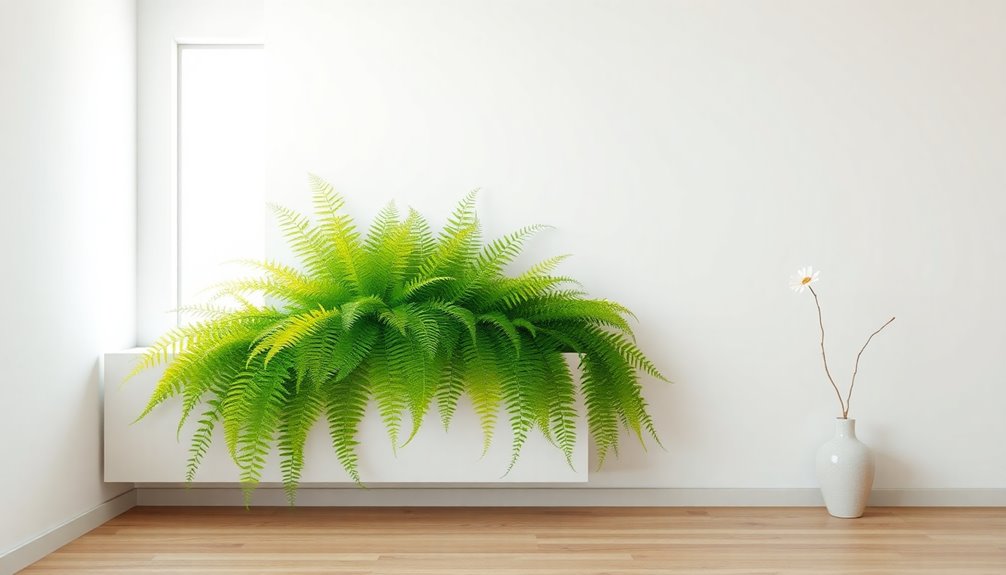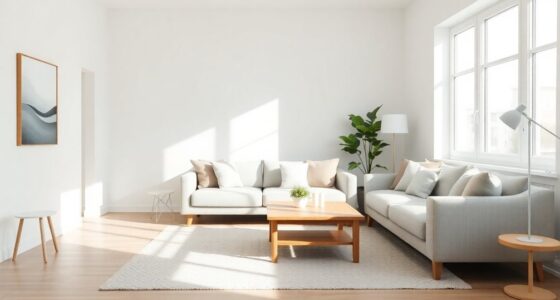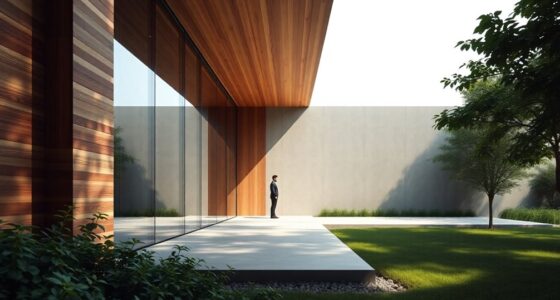Biophilic minimalism blends the calming aspects of nature with a clean, uncluttered aesthetic. You can bring nature indoors by using natural materials, maximizing natural light, and incorporating indoor plants. This design philosophy improves your well-being and creates a serene atmosphere. Think of features like living walls or natural sound elements to enhance relaxation. By embracing this style, you'll foster a deeper connection to your environment. Discover more ways to enhance your space seamlessly.
Key Takeaways
- Biophilic minimalism combines clean aesthetics with natural elements, fostering a serene indoor environment that promotes well-being.
- Incorporating indoor plants enhances air quality, reduces stress, and strengthens the connection to nature.
- Utilizing natural materials like wood and stone adds warmth and authenticity while improving indoor air quality.
- Maximizing natural light through large windows and strategic placements boosts mood, productivity, and sleep quality.
- Simplifying decor with a calming color palette and multifunctional furniture supports an organized, clutter-free living space.
Understanding Biophilic Minimalism

When you explore biophilic minimalism, you discover a design philosophy that beautifully marries the simplicity of minimalism with the enriching elements of nature. This approach emphasizes a clean, uncluttered aesthetic while fostering a deep connection to nature.
By maximizing natural light and incorporating a limited number of natural materials, like wood and stone, you create calming environments that transform spaces into peaceful retreats. Adding indoor plants enhances air quality and reduces stress, promoting your overall well-being.
With a focus on thoughtful decor choices, you prioritize functional, sustainable pieces that reflect natural textures and colors. Ultimately, biophilic minimalism nurtures a harmonious relationship between your indoor spaces and the natural world outside, fulfilling your inherent desire to connect with nature. Embracing the elegance of simplicity allows you to create serene environments that resonate with your lifestyle.
Core Principles of Biophilic Design

Biophilic design rests on several core principles that enhance your connection to nature within built environments. By using natural materials like wood and stone, you create tactile and visual connections that foster well-being. Incorporating indoor greenery through plants not only elevates aesthetics but also improves air quality and reduces stress. Architectural features such as living walls and vertical gardens further integrate natural elements, making spaces healthier and more inviting. Water features and natural sounds contribute calming effects, enriching your sensory experience. Additionally, a well-organized environment can reduce stress levels, enhancing the overall benefits of biophilic design.
| Principle | Description |
|---|---|
| Natural Materials | Use materials like wood and stone. |
| Indoor Greenery | Incorporate plants for health. |
| Calming Features | Add water elements and natural sounds. |
The Importance of Natural Light

Natural light plays an essential role in enhancing your connection to nature within indoor environments. It markedly boosts your mood and overall well-being while reducing stress levels.
Studies reveal that exposure to natural light can improve productivity by up to 20%, sharpening your focus and creativity. To maximize these health benefits, consider incorporating large windows and skylights, which not only brighten your space but also decrease reliance on artificial lighting, leading to lower energy consumption.
Additionally, access to natural light can positively influence your sleep patterns, helping you achieve better sleep quality and duration. Plus, it aids in vitamin D production, essential for healthy bones and a robust immune system, reinforcing its importance in bringing nature indoors. Furthermore, necessary cookies ensure that essential site features remain functional, which can enhance your overall browsing experience.
Integrating Natural Materials
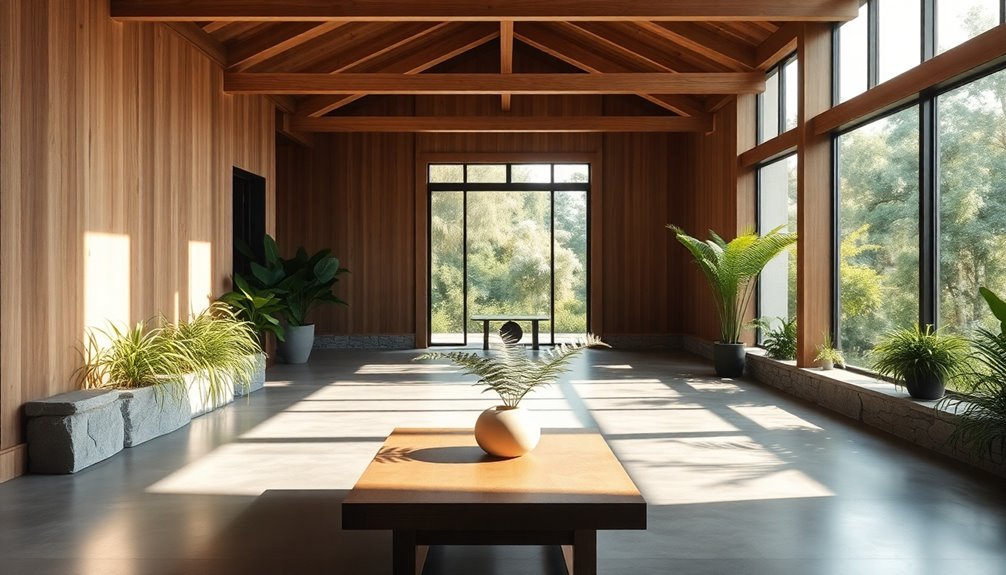
Integrating natural materials into your space not only beautifies it but also strengthens your bond with the environment. By incorporating elements like reclaimed wood, natural stone, and bamboo, you create a tactile connection to nature that enhances your minimalist design.
These natural materials are visually appealing and promote sustainability, often requiring less energy to produce, which can lower your carbon footprint. Additionally, they help improve indoor air quality by regulating humidity and temperature, fostering a healthier living environment.
Natural stone countertops or wooden furniture can evoke warmth and comfort, creating a calming atmosphere. Embracing these organic materials supports biophilic design principles, emphasizing the importance of connecting with nature to enhance your well-being and reduce stress. Furthermore, incorporating vintage or distressed furniture can add authenticity and character to your minimalist space.
Creating Indoor Green Spaces
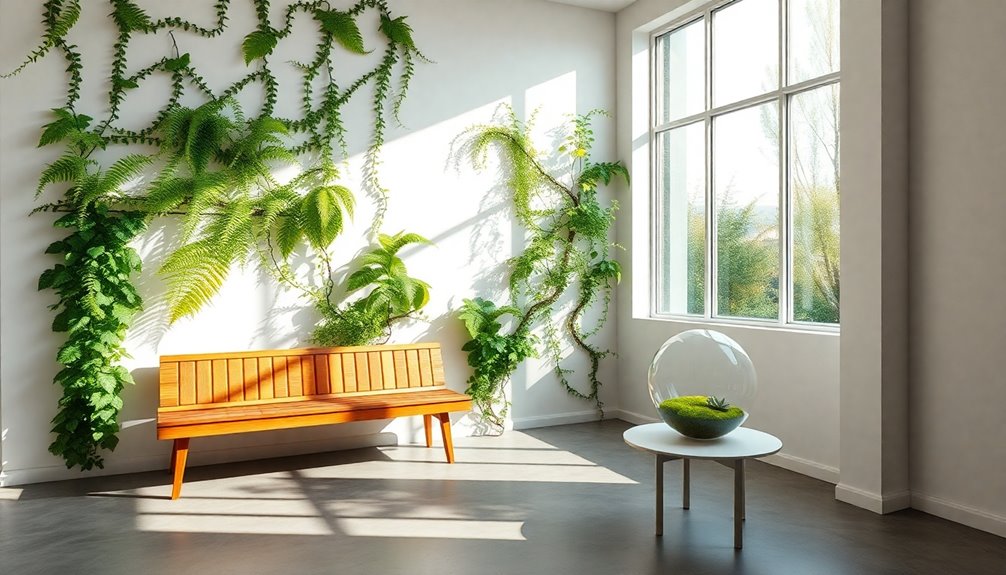
Bringing greenery into your home can transform your space into a tranquil sanctuary. By incorporating indoor plants like ferns and pothos, you can improve air quality and create a more inviting atmosphere.
Consider adding vertical gardens or living walls to utilize limited floor space while enhancing visual interest and biodiversity. Large windows or skylights can flood your interiors with natural light, promoting plant growth and connecting you with the outdoors.
Use natural materials like reclaimed wood and stone to elevate the aesthetic of your indoor gardening setups, emphasizing sustainability. Incorporating self-watering planters can further simplify care while ensuring your plants thrive.
Establishing multi-functional spaces that blend greenery with living areas fosters a harmonious balance between nature and daily life, ultimately enhancing your well-being and productivity in a biophilic design approach.
Practical Tips for Biophilic Minimalism

Embracing biophilic minimalism means creating a serene environment that connects you to nature while maintaining simplicity.
Start by incorporating a few carefully selected indoor plants that thrive in your specific light conditions, enhancing air quality while keeping a minimalist aesthetic.
Incorporate select indoor plants suited to your light conditions for improved air quality and a minimalist look.
Use natural materials like reclaimed wood and stone for furniture and decor, adding texture and reinforcing your connection to nature without overwhelming the space.
Maximize natural light by positioning mirrors to reflect sunlight and arranging furniture to avoid blocking windows.
Choose multifunctional furniture that marries practicality with organic design, ensuring every piece serves a purpose.
Finally, simplify your color palette to earthy tones inspired by nature, promoting a calming atmosphere that aligns with biophilic design principles. Additionally, the incorporation of natural elements can greatly enhance the tranquility of your space.
Future Trends in Biophilic Design
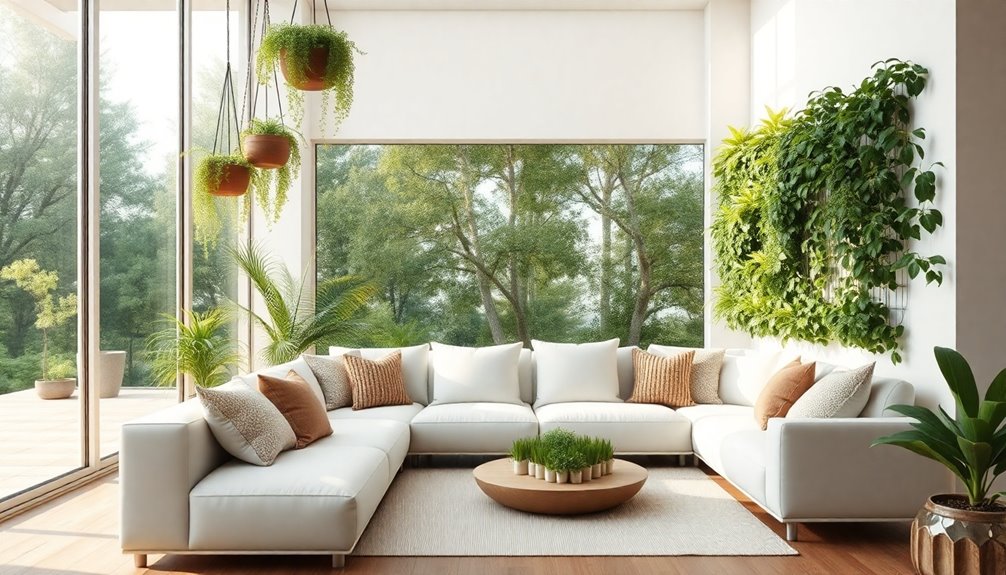
As you explore the future of biophilic design, you'll notice a strong focus on technology that integrates nature into your living space.
Innovations like smart home systems will help you optimize energy efficiency while bringing greenery into urban settings through features like green roofs and vertical gardens.
This shift not only enhances your well-being but also fosters a deeper connection to the natural world around you.
Nature-Integrated Technology Solutions
While exploring the future of biophilic design, you'll find that nature-integrated technology solutions are transforming how we interact with our environments.
Innovations like smart lighting systems mimic natural sunlight patterns, boosting your mood and productivity. Automated window systems optimize ventilation and light, reducing your reliance on artificial solutions and promoting a healthier indoor climate.
Living walls equipped with sensors monitor plant health, enhancing indoor air quality while adding aesthetic value with natural materials such as stone.
Virtual reality technologies offer therapeutic benefits by simulating calming natural environments, especially in urban settings. Plus, augmented reality allows you to visualize biophilic spaces before implementation, fostering a deeper connection to the natural world right from the start. Additionally, incorporating energy-efficient systems such as heat pumps can significantly enhance the comfort and sustainability of indoor spaces.
Urban Greenery Innovations
The rise of biophilic design extends beyond technology, embracing urban greenery innovations that are reshaping city environments.
Vertical gardens and green roofs are sprouting up everywhere, cutting urban heat by up to 5°F and markedly improving air quality. You'll love how smart irrigation systems are also integrated into these projects, slashing water usage by nearly 50% compared to traditional methods.
Additionally, living walls made from modular systems simplify installation and maintenance while fostering biodiversity.
Research shows that incorporating these natural materials into urban settings boosts overall well-being by 20%, enhancing your psychological and emotional health.
With cities like Toronto mandating green roofs, it's clear urban greenery isn't just a trend; it's an essential part of our future.
Frequently Asked Questions
What Is the Biophilic Approach in Interior Design Reconnecting Indoors With Nature?
The biophilic approach in interior design reconnects you with nature by integrating natural elements into your living space.
You can maximize natural light with strategically placed windows and reflective surfaces, while incorporating indoor plants to enhance air quality.
Using organic materials like wood and stone adds a tactile connection to the environment.
This design philosophy reduces stress and boosts your well-being, creating a harmonious atmosphere that promotes productivity and relaxation in your home.
What Is the Word for Bringing Nature Indoors?
The word for bringing nature indoors is "biophilia." It describes your natural connection to the environment and how you can enhance your living space by integrating elements from nature.
You can transform your home with plants, natural light, and organic materials, creating a soothing atmosphere.
How Do You Bring Nature Into Interior Design?
To weave nature into your interior design, think of your space as a canvas waiting for vibrant strokes.
Start by adding indoor plants like succulents or ferns, tailored to your light conditions. Embrace natural materials—reclaimed wood, stone—creating warmth and texture.
Let sunlight dance through sheer window treatments, and consider a small fountain for soothing sounds.
Finally, a living wall can serve as a breathtaking focal point, breathing life into your home.
What Is a Biophilic Indoor Environment?
A biophilic indoor environment is one that integrates natural elements to foster a deeper connection with nature.
You'll find features like plants, natural light, and organic materials that create a soothing atmosphere.
This design approach enhances your well-being by reducing stress and improving air quality.
Conclusion
Embracing biophilic minimalism transforms your space into a serene sanctuary, where nature whispers through every corner. By weaving in natural light, materials, and greenery, you create an inviting tapestry that nurtures your spirit. Picture stepping into a room that breathes with life, where the calm rustle of leaves and the warmth of sunlight cradle you. As you explore this harmonious blend, you're not just designing; you're cultivating a vibrant ecosystem that rejuvenates the soul and enhances well-being.
